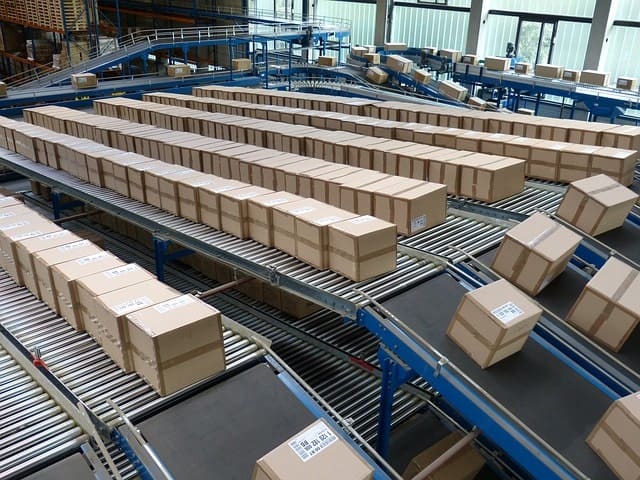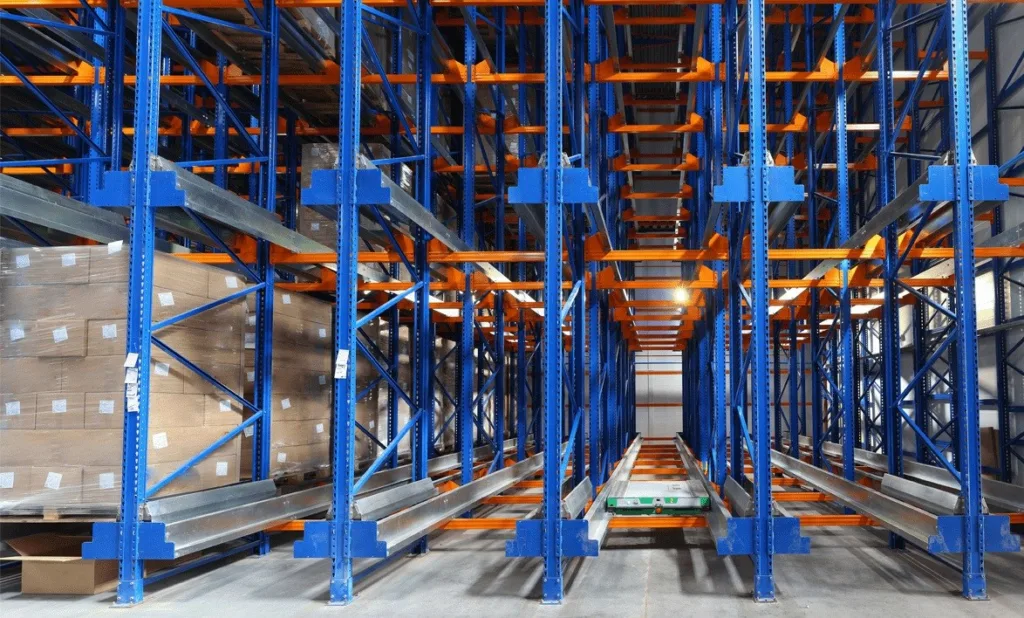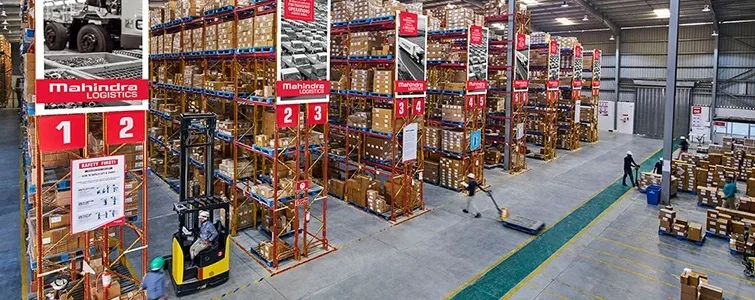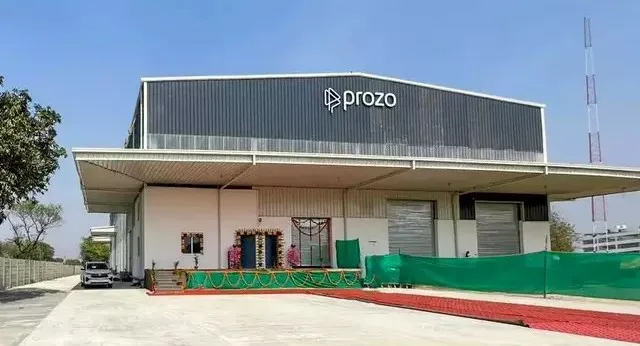Warehouses are increasingly adopting automation to handle repetitive and labor-intensive tasks. It automates various warehouse processes, including inventory management, order fulfillment, tracking, and reporting. It enables real-time visibility into stock levels, improves accuracy, and enhances overall operational efficiency. This allows associates to devote their attention to more intricate tasks. Warehouse automation comes in diverse forms, such as machines and robots that support workers in managing inventory from its arrival at the warehouse until it is dispatched. Utilising warehouse automation solutions can assist warehouses in boosting productivity and precision, lowering labour expenses, and enhancing safety.
What is warehouse automation
Warehouse automation refers to the implementation of technological systems and processes to streamline and optimize various aspects of warehouse operations. It involves the use of machines, robots, software, and other advanced technologies to automate and improve tasks related to inventory management, order fulfillment, picking and packing, sorting, transportation, and other warehouse processes. The goal of warehouse automation is to increase efficiency, accuracy, and productivity while reducing labor costs and enhancing safety in the warehouse environment. By automating tedious and repetitive tasks, human workers can focus on more complex and value-added activities, ultimately improving overall warehouse performance.
Advantages
Warehouse automation offers several benefits that can positively impact businesses. Here are some key benefits of implementing warehouse automation:
- Increased warehouse throughput
- Better resource utilization
- Reduced labor and operational costs
- Improved customer service
- Reduced handling and storage costs
- Reduced human error
- Minimized manual labor
- Increased productivity and efficiency
- Improved employee satisfaction
- Enhanced data accuracy and analysis
- Reduced stockout events
- Optimized warehouse space
- Greater inventory control
- Improved workplace safety
- Fewer shipping errors
- Reduced inventory loss
- Enhanced material handling coordination
- Improved order fulfillment accuracy
Technologies used for warehouse automation
There are various technologies used for warehouse automation, each serving different purposes and optimizing different aspects of warehouse operations. Here are some commonly used technologies for warehouse automation:
1. Conveyor Systems: Conveyor systems are a fundamental automation technology used in warehouses. They transport goods and materials between different areas of the warehouse, such as from receiving to storage or from storage to order fulfillment. Conveyor systems can be powered by motors or gravity and are essential for efficient material handling.

2. Automated Storage and Retrieval Systems (AS/RS): AS/RS are robotic systems that automate the storage and retrieval of goods in a warehouse. These systems typically consist of racks, shelves, and robotic cranes that retrieve items based on demand. AS/RS maximize space utilization, improve inventory management, and increase efficiency by automating the movement of goods within the warehouse.

3. Robotics: Robotics technology plays a crucial role in warehouse automation. Robotic systems can handle various tasks, such as picking, sorting, packing, and palletizing. Autonomous mobile robots (AMRs) are used for goods-to-person picking, where they navigate the warehouse floor to retrieve items and bring them to human operators for further processing.

4. Warehouse Management Systems (WMS): WMS is a software technology that helps manage and optimize warehouse operations. WMS systems provide functionalities such as inventory management, order fulfillment, labor management, and real-time visibility into warehouse activities. They integrate with other automation technologies to streamline operations and provide data-driven insights for decision-making.
5. Barcode Scanning and RFID: Barcode scanning and RFID (Radio Frequency Identification) technologies are used for automated identification and tracking of inventory. Barcode scanners and RFID readers are employed to capture data encoded on labels or tags attached to products, enabling accurate inventory management, order tracking, and automated sorting.

6. Automated Guided Vehicles (AGVs): AGVs are robotic vehicles that navigate autonomously within the warehouse to transport goods. They can move pallets, racks, or individual items from one location to another, eliminating the need for manual material handling. AGVs are equipped with sensors and navigation systems to ensure safe and efficient movement within the warehouse.

7. Pick-to-Light and Put-to-Light Systems: Pick-to-light and put-to-light systems use light indicators to guide warehouse workers in the picking and sorting processes. These systems utilize display modules with lights mounted on racks, shelves, or bins to indicate the location and quantity of items to be picked or stored. Workers follow the lights to quickly and accurately complete tasks.
8. Automated Guided Carts (AGCs): AGCs are smaller automated vehicles designed for material transport within a warehouse. They are typically used for moving smaller loads or individual items, such as to replenish picking areas or transport items between workstations. AGCs are guided by embedded sensors or magnetic strips on the floor.

9. Voice-directed Picking Systems: Voice-directed picking systems use speech recognition technology to guide warehouse workers in the picking process. Workers wear headsets that provide verbal instructions on what items to pick and where to find them. Voice-directed systems enhance accuracy, efficiency, and hands-free operation in the picking process.
These technologies can be combined and customized based on the specific needs and requirements of a warehouse, allowing businesses to automate various aspects of their operations and achieve greater efficiency, accuracy, and productivity
Demand for warehouse automation in India
The warehouse automation market in India has experienced a significant rise in the adoption of automation technologies across various sectors including logistics, e-commerce, retail, and manufacturing units. The growth in the e-retail sector and the implementation of the Goods and Services Tax (GST) facilitated the expansion of the warehouse automation market in India. Additionally, the evolution of advanced technological solutions in India such as artificial intelligence (AI), Industrial Internet of Things (IIoT), and Blockchain, and their application in warehousing are compelling supply chain operators to adopt automated systems. The increasing adoption of automation technologies is driven by several factors specific to the Indian market:
1. Rapidly Growing E-commerce Sector: India’s e-commerce industry has been experiencing significant growth, fueled by increasing internet penetration, smartphone usage, and changing consumer preferences. E-commerce companies require efficient warehousing and fulfillment operations to handle the growing volume of orders, leading to a demand for automation solutions.
2. Supply Chain Optimization: Indian businesses are recognizing the importance of optimizing their supply chain operations to improve efficiency and meet customer expectations. Warehouse automation plays a crucial role in streamlining processes, reducing lead times, minimizing errors, and ensuring faster order fulfillment, thus enhancing the overall supply chain performance.
3. Labor Availability and Cost: India has traditionally relied on manual labor-intensive processes in warehousing operations due to the availability of a large workforce. However, rising labor costs, increasing competition for skilled labor, and the need for improved productivity have prompted businesses to explore automation as a solution to address these challenges.
4. Improved Inventory Management: Effective inventory management is essential for businesses to avoid stockouts, optimize storage space, and reduce carrying costs. Warehouse automation technologies, such as AS/RS and IoT-enabled systems, enable accurate inventory tracking, real-time visibility, and efficient utilization of warehouse space.
5. Government Initiatives: The Indian government’s focus on initiatives like “Make in India” and “Digital India” has propelled the growth of industries such as manufacturing, logistics, and warehousing. To support these initiatives, businesses are increasingly investing in automation technologies to enhance their competitiveness, operational efficiency, and compliance with quality standards.
6. Increasing Consumer Expectations: Indian consumers are becoming more demanding in terms of faster order fulfillment, accurate deliveries, and a seamless shopping experience. Warehouse automation enables businesses to meet these expectations by reducing order processing times, improving accuracy, and enabling faster order dispatch and last-mile delivery.
The warehouse automation market in India is highly fragmented, with small organizations, such as Addverb Technologies Private Limited, Falcon Autotech Private Limited, and Grey Orange India Private Limited, driving the market. Grey Orange is a leading provider of Automated Guided Vehicles (AGV) and Autonomous Mobile Robots (AMR) solutions in the market, whereas Falcon Autotech and Addverb Technologies provide warehouse management software (WMS) to their clients. With technological innovations and advancements in the market, companies intend to expand their verticals in other warehousing solutions as well.
Companies incorporating warehouse automation in India
Several companies in India have been adopting warehouse automation to improve their operational efficiency and meet the growing demands of the market.
1. Flipkart: Flipkart, one of India’s leading e-commerce companies, has been investing in warehouse automation to enhance its supply chain operations. They have implemented technologies such as automated conveyor systems, sortation centres, and robotic systems for sorting and packaging to improve order processing times and ensure timely deliveries.

2. Amazon India: Amazon India has been at the forefront of warehouse automation in the country. They utilise a combination of automated storage systems, robotic arms for picking and packing, and advanced sorting technologies in their fulfillment centres. Amazon’s focus on automation has helped them scale their operations and meet the demands of a rapidly growing customer base.
3. Delhivery: Delhivery, a prominent logistics and supply chain solutions provider in India, has been adopting warehouse automation technologies to enhance its capabilities. They have implemented AS/RS systems, conveyor systems, and robotics to improve their warehousing operations, reduce errors, and increase efficiency in order fulfillment.

4. Mahindra Logistics: Mahindra Logistics, a leading third-party logistics provider in India, has been incorporating automation in its warehouse operations. They have deployed AGVs for goods transportation, automated conveyor systems for material handling, and WMS for efficient inventory management and order processing.

5. Reliance Retail: Reliance Retail, a major player in India’s retail sector, has been investing in warehouse automation to optimize its supply chain. They have implemented AS/RS systems, robotic picking systems, and advanced analytics for demand forecasting and inventory optimization. These automation initiatives help them ensure timely replenishment and efficient store fulfillment.
6. DHL Supply Chain India: DHL Supply Chain, a global logistics and warehousing company, has been leveraging automation in its operations in India. They have integrated AS/RS, conveyor systems, robotics, and WMS to improve efficiency, inventory accuracy, and order fulfillment capabilities.

7. Prozo: Prozo, one of India’s fastest-growing ‘full-stack’ supply chain company, has set new benchmarks in automation with the launch of the Mini-Load Automated Storage and Retrieval System (mini-load ASRS). Through this deployment, Prozo has become the first 3PL company in India to have such an advanced technology integration into its supply chain management services and take one more step towards 100% automation of warehouses.

Implementation of warehouse automation
Implementing warehouse automation involves several steps and considerations. Here is a general overview of the process:
1. Assess Needs and Define Goals: Start by assessing the needs and requirements of the warehouse. Identify pain points, inefficiencies, and areas that can benefit from automation. Define clear goals and objectives for the automation project, such as improving order accuracy, increasing throughput, or reducing labour costs.
2. Conduct a Feasibility Study: Evaluate the feasibility of implementing warehouse automation. Consider factors such as budget, available space, existing infrastructure, and the complexity of warehouse operations. Determine the return on investment (ROI) and weigh the costs and benefits of automation.
3. Develop an Automation Plan: Create a detailed plan that outlines the specific automation technologies to be implemented and how they will integrate into existing processes. Determine the sequence of implementation and any necessary modifications to the warehouse layout or infrastructure.
4. Select Automation Technologies: Choose the appropriate automation technologies based on the needs identified in the assessment phase. This may include robotics, conveyors, AS/RS, barcode scanners, WMS software, or other technologies that align with the goals of the project.
5. Design the Automation System: Collaborate with automation solution providers or system integrators to design the automation system. Consider factors such as layout optimization, equipment placement, workflow design, and integration with existing systems. Ensure that the system is scalable, adaptable, and meets safety regulations.
6. Procure and Install Equipment: Procure the selected automation equipment and install it in the warehouse. This involves setting up conveyors, robotic systems, AGVs, storage systems, and other automation technologies according to the design specifications. Proper installation and configuration are essential to ensure optimal performance.
7. Integrate Software Systems: Integrate automation software systems, such as WMS, WCS, and control systems, with the hardware components. This includes configuring the software, setting up interfaces, and establishing data exchange between systems. Test the integration to ensure seamless communication and data flow.
8. Training and Workforce Transition: Provide training to warehouse personnel on operating and interacting with the new automation technologies. Help employees understand their new roles and responsibilities in the automated environment. Address any concerns or resistance to change and ensure a smooth transition.
9. Test and Optimise: Conduct thorough testing of the automation system to identify any issues or bottlenecks. Optimise processes, workflows, and configurations based on real-world performance data. Continuously monitor and fine-tune the system to maximise efficiency and address any operational challenges.
10. Monitor and Maintain: Implement a regular maintenance and monitoring program to ensure the smooth operation of the automation system. This includes routine inspections, equipment maintenance, software updates, and troubleshooting. Proactive maintenance helps prevent downtime and ensures optimal system performance.
Implementing warehouse automation requires careful planning, collaboration with experts, and a systematic approach. It is crucial to involve stakeholders, engage employees, and maintain open communication throughout the implementation process. By following these steps, businesses can successfully implement warehouse automation and reap the benefits of increased efficiency, accuracy, and productivity
Conclusion
Warehouse automation has emerged as a pivotal solution for enhancing efficiency in various warehouse processes. Furthermore, the implementation of warehouse automation solutions enhances accuracy and safety measures, minimising the risk of errors and accidents. As technology continues to advance, the future of warehouse automation holds great potential for further optimising warehouse operations and driving overall growth and success.

